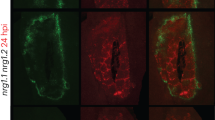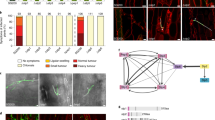Abstract
Failure of pathogenic fungi to breach the plant cell wall constitutes a major component of immunity of non-host plant species—species outside the pathogen host range—and accounts for a proportion of aborted infection attempts on ‘susceptible’ host plants (basal resistance)1,2,3,4. Neither form of penetration resistance is understood at the molecular level. We developed a screen for penetration (pen) mutants of Arabidopsis, which are disabled in non-host penetration resistance against barley powdery mildew, Blumeria graminis f. sp. hordei, and we isolated the PEN1 gene. We also isolated barley ROR2 (ref. 2), which is required for basal penetration resistance against B. g. hordei. The genes encode functionally homologous syntaxins, demonstrating a mechanistic link between non-host resistance and basal penetration resistance in monocotyledons and dicotyledons. We show that resistance in barley requires a SNAP-25 (synaptosome-associated protein, molecular mass 25 kDa) homologue capable of forming a binary SNAP receptor (SNARE) complex with ROR2. Genetic control of vesicle behaviour at penetration sites, and plasma membrane location of PEN1/ROR2, is consistent with a proposed involvement of SNARE-complex-mediated exocytosis and/or homotypic vesicle fusion events in resistance. Functions associated with SNARE-dependent penetration resistance are dispensable for immunity mediated by race-specific resistance (R) genes, highlighting fundamental differences between these two resistance forms.
This is a preview of subscription content, access via your institution
Access options
Subscribe to this journal
Receive 51 print issues and online access
$199.00 per year
only $3.90 per issue
Buy this article
- Purchase on Springer Link
- Instant access to full article PDF
Prices may be subject to local taxes which are calculated during checkout




Similar content being viewed by others
References
Johnson, L. E. B., Bushnell, W. R. & Zeyen, R. J. Defense patterns in nonhost higher plant species against two powdery mildew fungi. I. Monocotyledonous species. Can. J. Bot. 60, 1068–1083 (1982)
Freialdenhoven, A., Peterhänsel, C., Kurth, J., Kreuzaler, F. & Schulze-Lefert, P. Identification of genes required for the function of non-race-specific mlo resistance to powdery mildew in barley. Plant Cell 8, 5–14 (1996)
Hoogkamp, T. J. H., Chen, W. Q. & Niks, R. E. Specificity of prehaustorial resistance to Puccinia hordei and to two inappropriate rust fungi in barley. Phytopathology 88, 856–861 (1998)
Mellersh, D. G., Foulds, I. V., Higgins, V. J. & Heath, M. C. H2O2 plays different roles in determining penetration failure in three diverse plant-fungal interactions. Plant J. 29, 257–268 (2002)
Hammond-Kosack, K. E. & Parker, J. E. Deciphering plant-pathogen communication: fresh perspecitives for molecular resistance breeding. Curr. Opin. Biotechnol. 14, 177–193 (2003)
Peterhänsel, C., Freialdenhoven, A., Kurth, J., Kolsch, R. & Schulze-Lefert, P. Interaction analyses of genes required for resistance responses to powdery mildew in barley reveal distinct pathways leading to leaf cell death. Plant Cell 9, 1397–1409 (1997)
Sanderfoot, A. A., Assaad, F. F. & Raikhel, N. V. The Arabidopsis genome. An abundance of soluble N-ethylmaleimide-sensitive factor adaptor protein receptors. Plant Physiol. 124, 1558–1569 (2000)
Blatt, M. R. Toward understanding vesicle traffic and the guard cell model. New Phytol. 153, 405–413 (2002)
Jahn, R., Lang, T. & Südhof, T. C. Membrane fusion. Cell 112, 519–533 (2003)
Fasshauer, D., Sutton, R. B., Brunger, A. T. & Jahn, R. Conserved structural features of the synaptic fusion complex: SNARE proteins reclassified as Q- and R-SNAREs. Proc. Natl Acad. Sci. USA 95, 15781–15786 (1998)
Shen, Q. H. et al. Recognition specificity and RAR1/SGT1 dependence in barley Mla disease resistance genes to the powdery mildew fungus. Plant Cell 15, 732–744 (2003)
Lerman, J. C., Robblee, J., Fairman, R. & Hughson, F. M. Structural analsysis of the neuronal SNARE protein syntaxin-1A. Biochemistry 39, 8470–8479 (2000)
Munson, M., Chen, X., Cocina, A. E., Schultz, S. M. & Hughson, F. M. Interactions within the yeast t-SNARE Sso1p that control SNARE complex assembly. Nature Struct. Biol. 7, 894–902 (2000)
Misura, K. M. S., Scheller, R. H. & Weis, W. I. Self-association of the H3 region of syntaxin 1A. J. Biol. Chem. 276, 13273–13282 (2001)
Hückelhoven, R., Fodor, J., Preis, C. & Kogel, K. H. Hypersensitive cell death and papilla formation in barley attacked by the powdery mildew fungus are associated with hydrogen peroxide but not with salicylic acid accumulation. Plant Physiol. 119, 1251–1260 (1999)
Lauber, M. H. et al. The Arabidopsis KNOLLE protein is a cytokinesis-specific syntaxin. J. Cell Biol. 139, 1485–1493 (1997)
Betz, W. J. & Richards, D. A. What goes out must come in. Nature Neurosci. 3, 636–637 (2000)
Emans, N., Zimmerman, S. & Fischer, R. Uptake of fluorescent marker in plant cells is sensitive to brefeldin A and wortmannin. Plant Cell 14, 71–86 (2002)
Lamb, C. & Dixon, R. A. The oxidative burst in plant disease resistance. Annu. Rev. Plant Physiol. Plant Mol. Biol. 48, 251–275 (1997)
Snyder, B. A. & Nicholson, R. L. Synthesis of phytoalexins in sorghum as a site-specific response to fungal ingress. Science 248, 1637–1639 (1990)
Adam, L. & Somerville, S. C. Genetic characterization of five powdery mildew disease resistance loci in Arabidopsis thaliana. Plant J. 9, 341–356 (1996)
Yu, Y. et al. A bacterial artificial chromosome library for barley (Hordeum vulgare L.) and the identification of clones containing putative resistance genes. Theor. Appl. Genet. 101, 1093–1099 (2000)
Koga, H., Bushnell, W. R. & Zeyen, R. J. Specificity of cell type and timing of events associated with papilla formation and the hypersensitive reaction in leaves of Hordeum vulgare attacked by Erysiphe graminis f. sp hordei. Can. J. Bot. 68, 2344–2352 (1990)
Sutton, R. B., Fasshauer, D., Jahn, R. & Brunger, A. T. Crystal structure of a SNARE complex involved in syntaptic exocytosis at 2.4 Å resolution. Nature 395, 347–353 (1998)
Acknowledgements
This work was supported by Syngenta, the Max Planck Society, the Gatsby Charitable Foundation, the Danish Agricultural and Veterinary Research Council, the GABI Non-host Resistance Consortium (Bundesministerium für Bildung und Forschung), the Carnegie Institution of Washington, and the US Department of Energy. M.S. was supported in part by a Stanford Graduate Fellowship. N.C.C. thanks the host group of K. Shirasu in the Sainsbury Laboratory. We thank R. Bradbourne and H. Tippmann for technical assistance; M. Gale for microsatellite primers; M. Miklis and J. Uhrig for silencing and yeast two-hybrid vectors; R. Serrano and R. Napier for H+-ATPase and CALRETICULIN antisera; and R. Oliver for the GUS reporter construct.
Author information
Authors and Affiliations
Corresponding author
Ethics declarations
Competing interests
The authors declare that they have no competing financial interests.
Supplementary information
Rights and permissions
About this article
Cite this article
Collins, N., Thordal-Christensen, H., Lipka, V. et al. SNARE-protein-mediated disease resistance at the plant cell wall. Nature 425, 973–977 (2003). https://doi.org/10.1038/nature02076
Received:
Accepted:
Issue Date:
DOI: https://doi.org/10.1038/nature02076
This article is cited by
-
Genome-wide association mapping for seedling and adult resistance to powdery mildew in barley
Theoretical and Applied Genetics (2024)
-
Evaluation of the risk of development of resistance to QoI fungicide ZJ0712 in Podosphaera xanthii under greenhouse conditions
Phytopathology Research (2022)
-
SYP72 interacts with the mechanosensitive channel MSL8 to protect pollen from hypoosmotic shock during hydration
Nature Communications (2022)
-
Foliar resistance to Rhizoctonia solani in Arabidopsis is compromised by simultaneous loss of ethylene, jasmonate and PEN2 mediated defense pathways
Scientific Reports (2021)
-
Salicylic Acid-Induced syntaxin Gene Expression Coexists with Enhanced Resistance against Colletotrichum gloeosporioides Infection in Cassava
Tropical Plant Biology (2021)
Comments
By submitting a comment you agree to abide by our Terms and Community Guidelines. If you find something abusive or that does not comply with our terms or guidelines please flag it as inappropriate.



